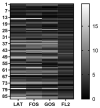Evaluation of Intestinal Microbial Metabolites in Preterm Infants with Different Initial Feeding Methods by In Vitro Fermentation Modeling System
- PMID: 35889172
- PMCID: PMC9318846
- DOI: 10.3390/microorganisms10071453
Evaluation of Intestinal Microbial Metabolites in Preterm Infants with Different Initial Feeding Methods by In Vitro Fermentation Modeling System
Abstract
We aim to explore the intestinal microbial metabolites in preterm infants with noninvasive methods and analyze the effects of initial feeding methods. Preterm infants with gestational weeks lower than 34 were recruited for fecal sample collection every 7 days. Fecal pH, ammonia, bile acid, and secretory IgA (sIgA) were tested. A 1:10 fecal slurry was inoculated into different culture media containing different carbohydrates as the only carbon source: lactose (LAT), fructooligosaccharide (FOS), galactooligosaccharide (GOS), and 2′-fucosyllactose (FL2). After 24 h of anaerobic culture through an in vitro fermentation system, air pressure difference, carbohydrate degradation rate, and short-chain fatty acids (SCFAs) content in fermentation pots were measured. Preterm infants were assigned into two groups: group A, preterm infants fed by human milk, including mother’s own milk and donor human milk (DHM); group B, preterm infants fed by preterm formula at first 3 days and fed by human milk (including mother’s own milk and DHM) from day 4 to discharge. Group A included 90 samples and group B included 70 samples. Group A had lower fecal pH (p = 0.023), ammonia (p = 0.001), and bile acids (p = 0.025). Group B also had higher fecal sIgA levels, both in OD (p = 0.046) and concentration (p < 0.0001) methods. Carbohydrates degradation rates in group A were higher than group B, especially in LAT medium (p = 0.017) and GOS medium (p = 0.005). Gas production amount had no significant difference in all four media. Several different SCFAs in four kinds of different culture media in group A were higher than in group B, but valeric acid was lower in group A. The initial feeding methods may affect the preterm infants’ intestinal microecology and microbial metabolites for at least several weeks.
Keywords: human milk; initial feeding methods; intestinal metabolites; preterm infants.
Conflict of interest statement
The authors declare no conflict of interest.
Figures



Similar articles
-
Evolution of Intestinal Gases and Fecal Short-Chain Fatty Acids Produced in vitro by Preterm Infant Gut Microbiota During the First 4 Weeks of Life.Front Pediatr. 2021 Sep 27;9:726193. doi: 10.3389/fped.2021.726193. eCollection 2021. Front Pediatr. 2021. PMID: 34646797 Free PMC article.
-
Preterm Gut Microbiome Depending on Feeding Type: Significance of Donor Human Milk.Front Microbiol. 2018 Jun 27;9:1376. doi: 10.3389/fmicb.2018.01376. eCollection 2018. Front Microbiol. 2018. PMID: 29997594 Free PMC article.
-
Nutrition, growth, and allergic diseases among very preterm infants after hospital discharge.Dan Med J. 2013 Feb;60(2):B4588. Dan Med J. 2013. PMID: 23461996 Review.
-
Impact of mother's own milk vs. donor human milk on gut microbiota colonization in preterm infants: a systematic review.Microbiome Res Rep. 2024 Nov 21;4(1):8. doi: 10.20517/mrr.2024.44. eCollection 2025. Microbiome Res Rep. 2024. PMID: 40207271 Free PMC article. Review.
-
Influence of own mother's milk and different proportions of formula on intestinal microbiota of very preterm newborns.PLoS One. 2019 May 20;14(5):e0217296. doi: 10.1371/journal.pone.0217296. eCollection 2019. PLoS One. 2019. PMID: 31107919 Free PMC article.
Cited by
-
Characterising the metabolic functionality of the preterm neonatal gut microbiome prior to the onset of necrotising enterocolitis: a pilot study.BMC Microbiol. 2024 Dec 23;24(1):533. doi: 10.1186/s12866-024-03701-x. BMC Microbiol. 2024. PMID: 39716092 Free PMC article.
References
Grants and funding
LinkOut - more resources
Full Text Sources
Research Materials
Miscellaneous

